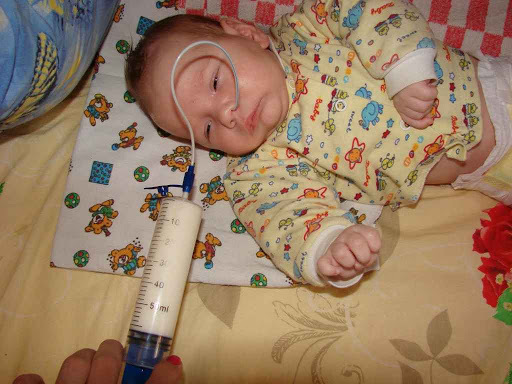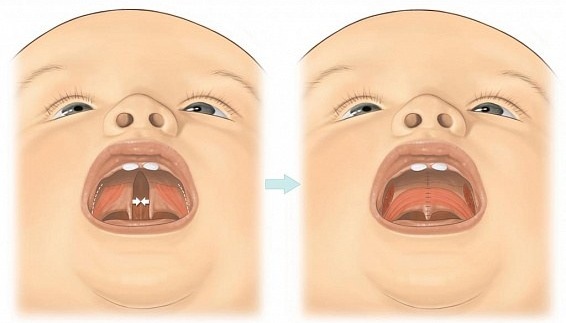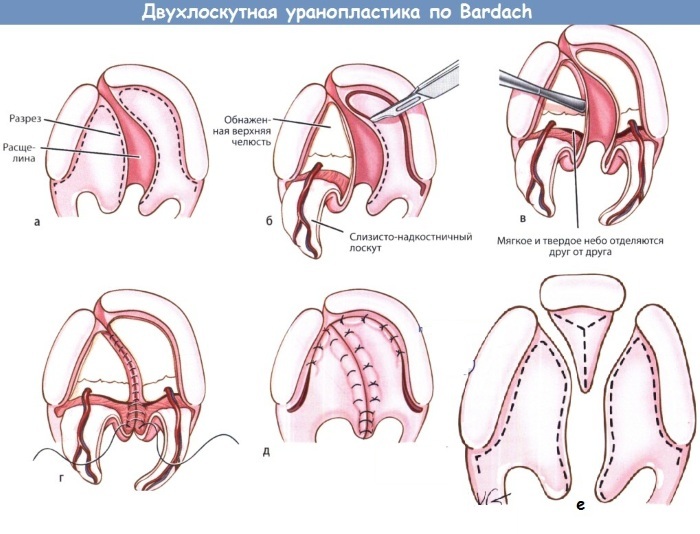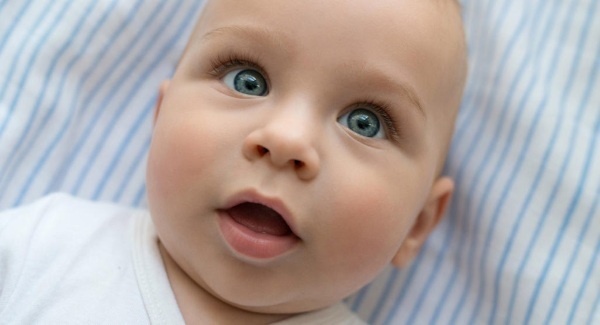Such congenital abnormalities, like cleft palate in children, correct in the first years of a baby's life. In the photo, you can see that the tissues of the sky form a cleft. Because of this defect, the child has difficulty eating and breathing. But with successful treatment and timely corrective assistance, the baby will not differ in development from other children.
Record content:
- 1 Definition of disease
- 2 Causes of the disease
- 3 Disease classification
- 4 Symptoms
- 5 Why is a wolf's mouth dangerous?
- 6 Diagnostics
- 7 Treatment and correction methods
- 8 Preoperative preparation
-
9 Types of operations
- 9.1 Cycloplasty
- 9.2 Uranoplasty
- 9.3 One-step plastic
- 9.4 Cheiloplasty
- 10 Postoperative care
- 11 Contraindications and complications
- 12 Cleft palate video
Definition of disease
The cleft palate in children, the photo of which can be seen below, is a non-fusion of the tissues of the hard and soft palate. The palate delimits the oral and nasal regions. In the fetus, the upper jaw forms at 8 weeks of gestation. If a genetic failure occurs at this time, then the appearance of this pathology occurs.
You can determine the presence of cleft palate by doing an ultrasound scan at 12-16 weeks of gestation. But the pediatrician will be able to assess the full presentation only after the birth of the baby. In the presence of this pathology, parents need to consult with a maxillofacial surgeon. In the future, children with a cleft palate are observed by an orthodontist, pediatrician and speech therapist.
Causes of the disease
This pathology is congenital, and experts believe that the cause of its appearance is a genetic failure.
The likelihood of having a child with this trait increases in the following cases if the expectant mother during pregnancy:
- suffers from alcohol, drug or tobacco addiction;
- takes medications that are not recommended for pregnant women;
- lives in an unfavorable environmental situation;
- suffers from excess weight, up to obesity;
- has a folate deficiency.

Also, the reasons that can provoke the appearance of a cleft palate include:
- unbalanced diet;
- frequent stress;
- trauma to the abdomen and any mechanical impact;
- viral and infectious diseases during pregnancy.
According to statistics, women whose age during gestation exceeds 35 years, the risk of giving birth to a baby with this pathology increases. Sometimes the cause of the cleft palate is heredity. In fact, it can be difficult to determine what caused the defect to appear.
Disease classification
The cleft palate in children (photos show that the degree of manifestation of the defect can be different) can be assessed by the severity of the pathology after the birth of the child. The duration and program of correctional work depends on this.
| A kind of pathology | Short description |
| Hidden | Only the muscles of the soft palate are split, the mucous membrane is in a normal state. It is possible to determine the presence of pathology only with in-depth diagnostics. |
| Incomplete | The cleft completely affects the soft palate and partially the hard palate. |
| Full | The tissues of the soft and hard palate are split, the pathology is pronounced. |
| Through | A cleft of the hard and soft palate, the alveolar process can be unilateral or bilateral. |

The cleft palate in children is classified according to external signs:
- obvious cleft, which can be seen during the initial external examination;
- hidden - there is a deep muscle defect, while the mucous membrane is not damaged. There is no damage in external diagnostics.
There is a combination of a cleft lip and a cleft palate, but this pathology is distinguished as a separate species.
Most often, the cleft palate can be diagnosed during the initial examination. But to determine the hidden option, additional diagnostics will be required.
Symptoms
The cleft palate in children, the photo of which is presented in this article, has a pronounced cosmetic defect.
This pathology has a number of symptoms that are an indicator of a violation of important vital processes:
- Violation of the breathing process, manifested already from birth. Because of the cleft palate, amniotic fluid can enter the baby's lungs. In the future, the child's breathing is difficult, shallow, shallow. All this can cause oxygen deficiency in the body.
- Violation of the processes of sucking and swallowing, parents feed the baby with the help of special spoons that are put on baby bottles. Due to difficulties in the feeding process, the baby lags behind in height and weight.
- Deformation of the bite.

Wolf's mouth in children
Therefore, babies are trying to carry out operations in the first year of life. The earlier correction work is started, the more efficiently it will be possible to correct disorders of important vital functions.
Why is a wolf's mouth dangerous?
The wolf's mouth in children is dangerous because even during childbirth, amniotic fluid can enter the lungs. Therefore, the baby is under the supervision of several specialists from birth.
This anomaly can cause the following problems:
- non-fusion of tissues of the soft palate causes a lag in speech development due to a violation of the process of sound production;
- due to breathing difficulties, the air does not have time to warm up, which can provoke the appearance of respiratory diseases. Due to the difficulty of the respiratory process, oxygen deficiency appears, which leads to impaired brain activity;
- fluid can enter the sinuses, causing otitis media and other hearing problems;
- violation of the processes of swallowing and sucking leads to the fact that the baby is poorly gaining weight and height. Also, during nutrition, the child does not receive additional nutrients, which affects the general condition of the body;
- violation of the bite leads to difficulties in chewing food and disruption of processes in the digestive tract. Sometimes a cleft causes abnormal tooth growth, caries;
- a cosmetic defect complicates social adaptation.
Treatment of the cleft palate should be comprehensive, because the anomaly affects important vital processes. To reduce the above problems to a minimum, the defect is corrected in the first years of the baby's life.
Diagnostics
It is possible to detect the presence of pathology during pregnancy using an ultrasound scan at 14-16 weeks. But it will be possible to confirm the diagnosis only after birth during an examination of the oral cavity. Doctors do more research to determine the amount of work.
The following types of diagnostics are carried out in a medical institution:
- x-ray of the maxillofacial area to assess the extent of damage;

- a hearing test is carried out with extensive crevices, when there is a risk of hearing impairment, up to deafness, due to the severity of pathology;
- diagnostics of smell is needed to assess facial expressions and the baby's reaction to smells;
- general blood analysis.
Based on the collected data, a correction program is drawn up.
Treatment and correction methods
Cleft palate can only be treated surgically. Several specialists are involved in further rehabilitation. The operation consists of several stages. The operation can be performed from 8 months.
Previously, surgery was not recommended because the mouth was too small. Up to 8 months, the emphasis is on supportive therapy. The operation is carried out taking into account the individual characteristics of the child and the severity of the defect.
After correcting the anomaly, the baby continues to be observed by a surgeon, orthodontist. Also, if necessary, they conduct classes with a speech therapist in order to correct speech development. If a child's operation was carried out in the first years of life, then he does not have problems with socialization. Therefore, postoperative work is based on the formation of the ability to breathe and swallow correctly.
Preoperative preparation
From the very birth of the baby, they begin to prepare for treatment.
The preoperative stage consists of:
- providing psychotherapeutic assistance to the family;
- organizing the correct balanced diet to solve the problem with weight deficiency;
- prevention of colds and ear diseases;
- dental care;
- speech therapy support.
Psychotherapy is needed to normalize the psychological situation in the family. Parents often feel guilty before their child, it is difficult for them to accept that their child is different from others. Psychotherapists explain to parents that this pathology is being successfully corrected, and in the future the child will not lag behind other children in development.
As they grow older, the specialist works with the baby so that he is not ashamed of his peculiarity. Psychotherapeutic support will help the child to socialize.
With this anomaly, the most difficult thing is to properly organize the feeding process so that food and liquid do not enter the nasal cavity. If the defect is not pronounced, special pads on the chest or a bottle are used to cover the cleft palate.
In severe cases, a special tube probe is used. It is inserted into the nasal region so that it reaches the stomach. The device is installed in the hospital and the parents are trained in its use. The probe is rearranged every 3 weeks to avoid complications.
Food is given in a grated form, because the child has impaired swallowing and chewing processes. Reduces the risk of food entering the respiratory tract. The baby's diet should have enough vitamins and useful macro- and microelements, because children with cleft palate have reduced immunity.
Before the operation, the baby should regularly consult an ENT doctor. Also, experts recommend limiting communication with others. Parents should keep the nasal cavity clean. Your doctor may recommend inserting a special tube to help prevent ear infections.
Children with cleft palate need to brush their teeth regularly with a silicone patch. In a year, parents come with the baby to the dentist's office to make corrections at the orthodontist if necessary.
At the age of 2 years, classes with a speech therapist are recommended. This is necessary to correct pronunciation and prevent the appearance of other problems in speech development.
Types of operations
The choice of the operating technique depends on the severity of the defect. Usually the surgeon performs bicycle plastic and uranoplasty.
Cycloplasty
Cycloplasty is the stitching of the cleft of the soft palate. It can be done from 8 months, and this technique is also carried out from a year to 2 years. Cycloplasty is tried before the period until the child begins to speak. Otherwise, defects in speech development may appear.
Cycloplasty normalizes the processes of swallowing and breathing. The surgeon prepares the triangular tissue in advance to suture the cleft of the soft palate. The tissue is taken from the oral mucosa. This technique is less traumatic. 2-3 days after it is carried out, you can switch from tube feeding to the usual one. When this happens, the tube is removed and the baby is discharged.
Uranoplasty
Uranoplasty is a hard palate correction. To do this, lengthen the soft palate and narrow the middle section of the pharynx. If the defect is pronounced, the operation is carried out in several stages. The first uranoplasty can be performed at 6 months.
Other surgical procedures are performed between the ages of 2 and 4 years. If the cleft is blind, then uranoplasty is done at 3-5 years old. If the through is unilateral, surgical interventions are performed at the age of 5-6 years. With a bilateral cleft, uranoplasty is performed in 2 stages with a difference of 6 months.
This technique is best done until the age of 6, until the child goes to school. After 6 years, cosmetology and cosmetic procedures are performed. There are cases when it is possible to completely get rid of the cleft palate only by the age of 18.
To close the cleft, the surgeon takes parts of the periosteum along with the vessels. These fragments are used to close the defect. Then the formation of bone tissue occurs. Uranoplasty is not advised to be performed at an early age, because it can delay the formation of bone tissue in the upper jaw.
One-step plastic
One-step plasty is done if the cleft is narrow or incomplete. After surgery, the anomaly is closed with tissue fragments from the nasal and oral cavities.
This technique does not solve all the problems. But the process of caring for and feeding a baby is simplified. It also reduces the likelihood of ear diseases. One-stage plastic creates all the conditions for the restoration of bone tissue, which contributes to the closure of the cleft.
Cheiloplasty
Cheiloplasty is used only when the baby has a cleft lip and a cleft palate at the same time. It can be done after 8 months. Previously, cheiloplasty is not done because the size of the oral and nasal cavities is too small.
With any type of surgery, there is a possibility that the tissues will grow unevenly. It can look unaesthetic from a cosmetic point of view, because scars and scars appear. But it is also not recommended to do them too late, because the correctness of the formation of the maxillofacial system depends on it.
All surgical interventions are performed under general anesthesia. Before that, the baby undergoes a course of antibiotics, and then pain medications are added. If there are no postoperative complications, the child is discharged after 3-4 weeks.
Postoperative care
During the rehabilitation period, experts advise adhering to the following recommendations:
- For 2-3 days, the baby is assigned to bed rest. Also, the baby must observe the silence mode for 10 days after the surgery.

- The postoperative sutures are bandaged with a disinfecting medicine. Dressings are done every 2-3 days so that there is no accumulation of mucus, saliva and blood in the area of \ u200b \ u200bthe palate. When the stitches are removed, the dressings are also removed.
- Food can only be given in a grated form.
- Be sure to include plenty of water in your diet.
- So that the baby does not have an inflammatory process, after each meal, you need to rinse with a solution of potassium permanganate.
- From the 2nd week during the rehabilitation period, the child is prescribed a palate massage to accelerate tissue regeneration. All movements should be gentle and smooth, because any mechanical impact causes painful sensations. Parents must follow the technique of execution.
After discharge, you need to make an appointment with the clinic for rehabilitation measures:
- speech therapy classes for the development of articulatory motor skills, improvement of the condition of the soft palate, the formation of correct speech breathing and massage. But it can be performed by a speech therapist who has undergone special training;
- physiotherapy procedures;
- the feeding process is carried out using a special orthodontic teat.
Observation by an orthodontist is a prerequisite, because he monitors the correctness of the formation of the jaw. They begin to work with a speech therapist and a defectologist only after 2 years.
The rehabilitation process is fully completed by the age of 6-7 years. And the child can attend ordinary educational institutions and keep up with the development of their peers.
Contraindications and complications
The cleft palate in children, the photo of which shows the peculiarities of the structure of the palate, is treated surgically at an early age.
But there are contraindications to the operation:
- congenital heart defects - before their correction;
- other severe congenital malformations of internal organs;
- anemia;

- pneumonia.
With the correction or complete elimination of these contraindications, the operation is possible. But for this you need to pass additional tests to check the condition of the child.
The cleft palate in children is successfully treatable. In the photo before and after you can see the result of the corrective work carried out on time. But there are times when postoperative complications occur. Most often, they arise due to a medical error.
Complications include:
- divergence of seams at the junction of tissues. In this case, a second operation is performed;
- parts of tissue taken from other parts of the body may not take root and die off. This problem is also solved by re-surgical intervention;
- the appearance of rough scars, the severity of which is regulated by cosmetic procedures;
- shortening the soft palate affects the development of speech. Therefore, in the postoperative period, the child attends speech therapy classes.
But complications after operations do not always arise and they can be eliminated so that the rehabilitation period is successful. To minimize the occurrence of complications, anamnestic data is collected.
The prognosis after the operation is favorable. After uranoplasty and cycloplasty, it is possible to completely correct the cleft palate. If all the recommendations are followed during the rehabilitation period, the development of the baby will not differ in any way from its peers. But the child will be able to completely stop receiving visits to doctors only by the time the bones finish forming.
Pathology such as cleft palate in children is very rare and can be successfully treated. Photos before and after the operation confirm the success of the treatment, but subject to all medical recommendations. It must be comprehensive in order for a child to grow up physically and mentally healthy.
Cleft palate video
Cleft palate in children:



